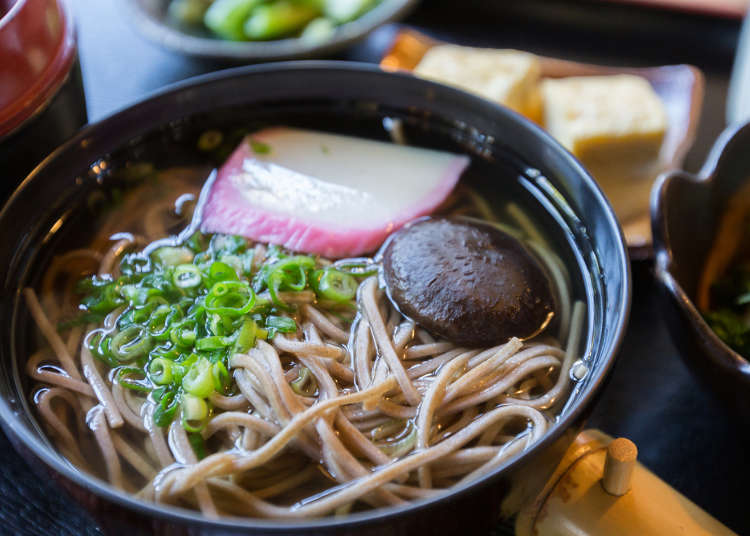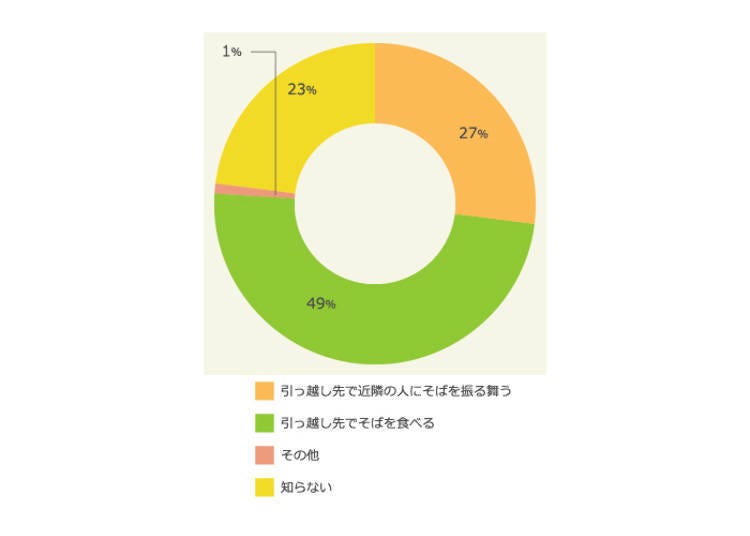
Japan is known to have a rich variety of different festivals and customs, the vast majority of them surrounding the four seasons. There is one custom, however, that even a lot of Japanese people are somewhat misinformed about.
Have you ever heard of “hikkoshi soba”, or “moving buckwheat noodles?” Don’t worry if you didn’t, the majority of non-Japanese people haven’t either and were rather surprised by it: “Combining the act of moving with a dish? That’s unique.”
But even half of Japanese natives don’t seem to know what hikkoshi soba are actually about. When do you eat them? Is it even something that you yourself eat? Let’s find out more about hikkoshi soba, the moving buckwheat noodles!
The Real Meaning of Hikkoshi Soba – an Enigma?

A company called Macromill conducted a survey which asked a total of 1,696 people between 18 and 59 years old what they knew about hikkoshi soba. When asked about the meaning of hikkoshi soba, 49% of people said that it’s the custom of eating buckwheat noodles after moving to a new place, while 27% said that it refers to the act of gifting soba to your new neighbors after moving. 23% of people had no idea at all.
Interestingly enough, half of the people, those who said that hikkoshi soba are eaten after moving in, are totally wrong! It is indeed the custom of giving your neighbor buckwheat noodles as a well-meaning gift. So, every second person who answered the survey actually misunderstood this century-old practice!
Hikkoshi Soba: Why Giving Noodles to Your Neighbor is a Thing

So, seeing that the people who actually gave the right answer when it came to the meaning of hikkoshi soba are a minority, let’s find out more about it.
This buckwheat noodle custom has its roots in Japan’s Edo period (1603 – 1868). During that time, numerous people used to live together in one house, often only separated by paper walls – thus, getting along with your neighbor was especially important back then. This is why, after moving in, people gifted soba noodles to their new neighbors as a friendly, well-meaning gesture.
Before the buckwheat noodles of hikkoshi soba became popular, people used to give rice porridge and azuki beans to their new neighbors. However, azuki became somewhat of a luxury food in the Edo period. “A cheaper gift would be better…” and “For a mere gesture after moving in, this is way too formal, isn’t it?” were sentences often muttered among the common folk of old Edo and it was clear that a substitute needed to be found.
And there was one dish that was especially popular among the people of Edo and not expensive at all: soba, buckwheat noodles. As such, the custom of gifting your neighbors hikkoshi soba instead of rice and red beans started to spread. But hikkoshi soba aren’t just cheap and delicious, they also carry a meaning. Their long form standing for a long and pleasant relationship with your new neighbors that you hope for when handing over the noodly present. This nice, yet meaningful gesture is something typical of the witty common folk of Edo.
Hikkoshi Soba - Going International?

As already mentioned, the custom of hikkoshi soba has made its way from the Edo period to these modern times, even if half of Japanese people misunderstand what the custom actually is supposed to look like. However, the practice is also well-received by Japan’s international population, even though many people might not have heard of hikkoshi soba at all!
“Well, of course I knew that soba is a staple food in Japan but I am still surprised that such a custom exists! It’s a very nice practice, and very Japanese, I think.” (male, United States)
“I am aware that it is a part of Japanese culture to eat soba during New Year’s, hoping for a long life. But that they’re even connected to moving, this country really is fond of soba, isn’t it?” (female, Germany)
So, the next time you find yourself moving in a new home, why don’t you try the custom of hikkoshi soba yourself? We’re sure you’ll have a long and positive relationship with your nerw neighbors!
▼ Survey Outline
Researcher: Macromill
Research Method: Internet
Nationwide survey, people of all genders between 18 and 59 (Macromill affiliates)
Allocation Method: gender x age, 1,696 participants in total
Survey Period: February 9th (Tue) to 12th (Fri) 2016
- Category
*Prices and options mentioned are subject to change.
*Unless stated otherwise, all prices include tax.
Popular Tours & Activitiess
Recommended places for you
-

Man in the MoonKarasuma
Other Restaurants
Gion, Kawaramachi, Kiyomizu-dera Temple
-

PASELANamba
Other Restaurants
Namba, Dotonbori, Shinsaibashi
-

fes Fuesu
Other Restaurants
Umeda, Osaka Station, Kitashinchi
-

BUDDY BUDDY
Other Restaurants
Sapporo / Chitose
-

Birthday Surprise x KUJIRA ENTERTAINMENT DINING
Other Restaurants
Shinjuku
-

Shabuzen Umeda
Other Restaurants
Umeda, Osaka Station, Kitashinchi
-
Ad

Get Your Perfect Custom Suit at GINZA Global Style PREMIUM Ginza Honten: Choose from 5,000 Fabrics, Starting at 26,400 Yen (incl. tax)!
-

The Ultimate Guide to Mitsui Outlet Parks in Japan (2025 Edition) - Popular Tax-Free Malls & Coupon Info for Travelers
by: Guest Contributor
-

Fine Dining on Rails? Japan Announces Stunning NEW 'Laview' Restaurant Train
-

10 Must-Buy Cosmetics at Don Quijote (2025 Edition)
-
Ad

Feeling Unwell While Traveling? HOTEL de DOCTOR 24 is Japan's Sole 24-Hour Online Medical Consultation Service
-
Ad

Okinawa Travel Troubles? Guide to the MCC Hotline for Illness and Weather Emergencies
-

The Best of Japan: 11 Major Cities Every Traveler Should Visit
-

Kaminoyama Onsen Guide: Best Things to Do in Japan's Samurai Town!
-

Where to Stay in Noboribetsu Onen: 6 Ryokan Hotels in Hokkaido's Spa Wonderland
by: Masakazu Yoshida
-

Top 3 Healthy Restaurants Serving Famous Kyoyasai - Heirloom Kyoto Vegetables!
-

Dining in Asakusa (Tokyo): Must-Try Restaurants from Sukiyaki to Street Snacks
by: Wong Man Yee
-

Crazy Japanese Drinks: These Expats Went Wild on Chuhai, Would You Try These?!
- #best sushi japan
- #what to do in odaiba
- #what to bring to japan
- #new years in tokyo
- #best ramen japan
- #what to buy in ameyoko
- #japanese nail trends
- #things to do japan
- #onsen tattoo friendly tokyo
- #daiso
- #best coffee japan
- #best japanese soft drinks
- #best yakiniku japan
- #japanese fashion culture
- #japanese convenience store snacks












